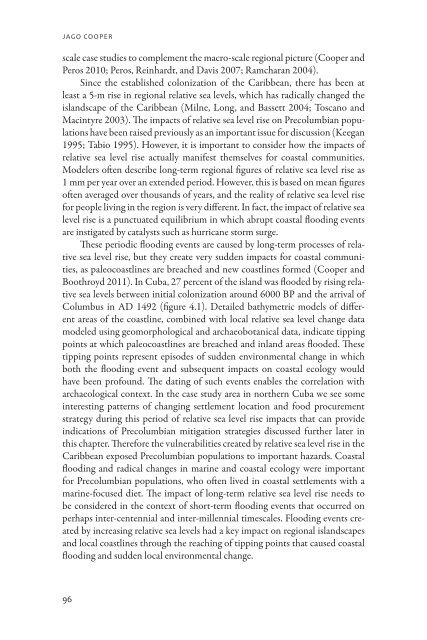free download - University Press of Colorado
free download - University Press of Colorado
free download - University Press of Colorado
Create successful ePaper yourself
Turn your PDF publications into a flip-book with our unique Google optimized e-Paper software.
Jago Cooper<br />
scale case studies to complement the macro-scale regional picture (Cooper and<br />
Peros 2010; Peros, Reinhardt, and Davis 2007; Ramcharan 2004).<br />
Since the established colonization <strong>of</strong> the Caribbean, there has been at<br />
least a 5-m rise in regional relative sea levels, which has radically changed the<br />
islandscape <strong>of</strong> the Caribbean (Milne, Long, and Bassett 2004; Toscano and<br />
Macintyre 2003). The impacts <strong>of</strong> relative sea level rise on Precolumbian populations<br />
have been raised previously as an important issue for discussion (Keegan<br />
1995; Tabio 1995). However, it is important to consider how the impacts <strong>of</strong><br />
relative sea level rise actually manifest themselves for coastal communities.<br />
Modelers <strong>of</strong>ten describe long-term regional figures <strong>of</strong> relative sea level rise as<br />
1 mm per year over an extended period. However, this is based on mean figures<br />
<strong>of</strong>ten averaged over thousands <strong>of</strong> years, and the reality <strong>of</strong> relative sea level rise<br />
for people living in the region is very different. In fact, the impact <strong>of</strong> relative sea<br />
level rise is a punctuated equilibrium in which abrupt coastal flooding events<br />
are instigated by catalysts such as hurricane storm surge.<br />
These periodic flooding events are caused by long-term processes <strong>of</strong> relative<br />
sea level rise, but they create very sudden impacts for coastal communities,<br />
as paleocoastlines are breached and new coastlines formed (Cooper and<br />
Boothroyd 2011). In Cuba, 27 percent <strong>of</strong> the island was flooded by rising relative<br />
sea levels between initial colonization around 6000 BP and the arrival <strong>of</strong><br />
Columbus in AD 1492 (figure 4.1). Detailed bathymetric models <strong>of</strong> different<br />
areas <strong>of</strong> the coastline, combined with local relative sea level change data<br />
modeled using geomorphological and archaeobotanical data, indicate tipping<br />
points at which paleocoastlines are breached and inland areas flooded. These<br />
tipping points represent episodes <strong>of</strong> sudden environmental change in which<br />
both the flooding event and subsequent impacts on coastal ecology would<br />
have been pr<strong>of</strong>ound. The dating <strong>of</strong> such events enables the correlation with<br />
archaeological context. In the case study area in northern Cuba we see some<br />
interesting patterns <strong>of</strong> changing settlement location and food procurement<br />
strategy during this period <strong>of</strong> relative sea level rise impacts that can provide<br />
indications <strong>of</strong> Precolumbian mitigation strategies discussed further later in<br />
this chapter. Therefore the vulnerabilities created by relative sea level rise in the<br />
Caribbean exposed Precolumbian populations to important hazards. Coastal<br />
flooding and radical changes in marine and coastal ecology were important<br />
for Precolumbian populations, who <strong>of</strong>ten lived in coastal settlements with a<br />
marine-focused diet. The impact <strong>of</strong> long-term relative sea level rise needs to<br />
be considered in the context <strong>of</strong> short-term flooding events that occurred on<br />
perhaps inter-centennial and inter-millennial timescales. Flooding events created<br />
by increasing relative sea levels had a key impact on regional islandscapes<br />
and local coastlines through the reaching <strong>of</strong> tipping points that caused coastal<br />
flooding and sudden local environmental change.<br />
96





